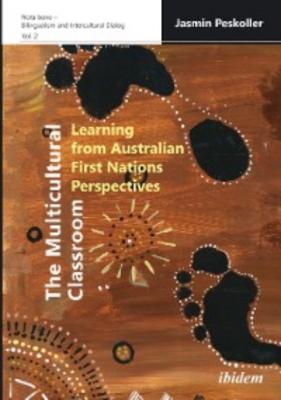The Multicultural Classroom: Learning from Australian First Nations Perspectives. Jasmin Peskoller
Читать онлайн.| Название | The Multicultural Classroom: Learning from Australian First Nations Perspectives |
|---|---|
| Автор произведения | Jasmin Peskoller |
| Жанр | Прочая образовательная литература |
| Серия | |
| Издательство | Прочая образовательная литература |
| Год выпуска | 0 |
| isbn | 9783838275871 |
in areas of the world with minority groups that come from immigration, rare is the country that has a deliberate education policy of allowing minority children to acquire and retain both their home, immigrant language and the majority language, and hence a policy of fostering bilingualism.
In order to receive a better idea of what education policies might or might not undertake in regards to the educational needs of their linguistic and cultural minorities, Churchill’s (1986) framework provides an overview of the “six principal policy responses to the educational and language needs of minority groups within the OECD” (May 2012, 18).10 These are presented in ascending order according to their degree of incorporation and recognition of minority languages in Table 4.
| Education Policy | Minority Aspiration |
| Learning deficit Socially-linked learning deficit Learning deficit from social/cultural differences | Recognition phase |
| Learning deficit from mother tongue deprivation | Start-up and extension phase |
| Private use language maintenance | Consolidation and adaption phase |
| Language Equality | Multilingual co-existence phase |
Table 4: Stages of Education Policies for Language Minority Groups11
Stage one policies strongly advocate a fast transition to the target language and claim that the use of minority languages is the reason for the educational disadvantage and failure of minority groups. Initial minority aspirations include efforts for the recognition of the existence and specific needs of linguistically and culturally diverse people. At stage two, family and social backgrounds are identified as the main cause for educational detriments for minorities. Thus, programs and projects are enforced to help minority groups adjust to the majority language and culture. Stage three policies recognize that disadvantages for minority groups in education grow from the lack of recognition, acceptance, and a positive attitude towards their languages and cultures. Level four acknowledges that the minority language needs to be supported at least temporarily to facilitate learning and thus incorporates it in the first years of schooling. From this type of transitional bilingualism, minority aspirations might aim at extending minority language programs. At stage five, termed the private use language maintenance, minority groups obtain the right to practice their home language and culture in their private lives. A common policy response at this level includes maintenance bilingualism programs in schools, i.e. ongoing schooling in the minority language. Minority aspirations at this stage focus on the improvement of quality and the incorporation of the minority culture in education. Finally, the minority language is granted official status and autonomy at the language equality stage. The latter encompasses an allocation of language programs in several public institutions over which minority groups obtain full control and which they organize and is thus termed the multilingual co-existence phase (May 2012, 19–31).
Linking education policies with multilingual education and First Nations perspectives, Hornberger (2009, 197) expresses a “deep conviction that multilingual education constitutes a wide and welcoming educational doorway toward peaceful coexistence of peoples and especially restoration and empowerment of those who have been historically oppressed.” Thus, proceeding from an Indigenous perspective, Hornberger proposes ten certainties about multilingual education policy and practice which are relevant for any classroom at a global age (Hornberger 2009, 197):
National multilingual language education policy opens up ideological and implementational spaces for multilingual education.
Local actors may open up—or close down—agentive spaces for multilingual education as they implement, interpret and perhaps resist policy initiatives.
Ecological language policies take into account the power relations among languages and promote multilingual uses in all societal domains.
Models of multilingual education instantiate linguistic and sociocultural histories and goals in each context.
Language status planning and language corpus planning go hand in hand.
Communicative modalities encompass more than written and spoken language.
Classroom practices can foster transfer of language and literacy development alongside receptive-productive, oral-written and L1-L2 dimensions, and across modalities.
Multilingual education activates voices for reclaiming the local.
Multilingual education affords choices for reaffirming our own.
Multilingual education opens spaces for revitalizing the Indigenous.
With these certainties and the revealed potential of multilingual education for Indigenous voices and perspectives in mind, the next chapter focuses on languages and cultures in Australia.
1 Modified from Edmondson & House 2011, 8.
2 This book makes use of the terms multilingualism and multilingual to refer to the totality of an individual’s or society’s linguistic resources. Bilingualism and bilingual is used with the same inclusive reference.
3 Data and Images retrieved from García 2009, 72–74.
4 Within the scope of this book, an exhaustive presentation of the concept of culture cannot be given. Therefore, an overview of select discussions in the field, and the definition of culture underpinning this research study, is provided.
5 Data retrieved from Baker 2011, 207.
6 Modified from Baker & Wright 2017, 199.
7 Data retrieved from Tedick, Christian & Fortune 2011, 2.
8 Data retrieved from Baker 2011, 239.
9 A specific analysis of education policies relevant for Indigenous Australian learners can be found in IV.5.
10 OECD is an acronym for the Organization for Economic Co-operation and Development, an international organization which was founded in 1961.
11 Modified from Churchill 1986, 157.
Конец ознакомительного фрагмента.
Текст предоставлен ООО «ЛитРес».
Прочитайте эту книгу целиком, купив полную
